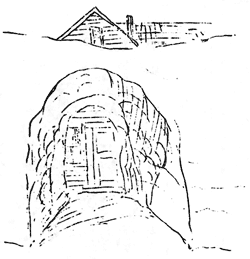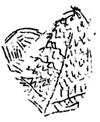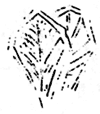An Arctic Approach
By R. P. Andrews, Park Ranger
“Oh, isn’t that the cutest thing! Stand over there, Junior, and let me take a picture of you”. Thus at least thirty times a day would park visitors rhapsodize during the first two weeks I checked cars at Annie Springs. Although “cute” was hardly the adjective to apply to an eighteen foot wall of snow — which is what it measured on April 23 — picturesque it certainly was. When it first attracted the attention of large numbers of people, on the day of the Medford opening, the snow wall, thrown by the plow, almost completely covered the Annie Springs cabin, one tiny portion of gable being perceptible. The tunnel leading to the front door had not yet been completely cut through — a feature which somewhat added to its mystery causing visitors to peer into the ice cave and wonder just what, if any, its purpose was.
When I first went on duty at Annie Springs for the summer on June 15, the aperture had widened so that five or six people might stand in it at once; the wall of snow had melted and flattened so that, instead of a flagpole surmounting a glacier, one could see the peaked roof of the log cabin. From then on it melted rapidly from both sides. The roof of the cave became thinner and narrower, and once could see the light shining through it during the last few days. On hot days visitors would rush into this cool retreat, exclaiming over the color of the walls. They were an icy blue-green, and the rough surface made them look as if they had been hewn out with an adze.
Once a mother bear with three small cubs essayed to climb the dizzy heights on top, in a vain search for food. A crowd at the checking station stood breathless as the old lady ambled over the span, the three cubs following in single file. Would it hold them up, or would they crash through? At this crucial point, a man came out of the front door, and through the tunnel. Much to his amazement, he was greeted with gales of laughter. He did not realize that to the others it looked like a game of “Heavy, heavy hangs over thy head.” Finally, the bear family, in disgust, wandered away, and our tunnel remained intact. Several rangers showed signs of disgust, too. It had been the picture of the year, and nobody at Annie Springs could find a camera.
By the twenty-eighth of June the four-foot span had narrowed and thinned until it was no more than six inches wide and less than half that in thickness. I knew it could not last much longer, and I kept glancing over that way, hoping to see the final cave-in. But I was not to be so fortunate. In the midst of checking over the travel figures, I heard a soft “plop”. Without ceremony, and with no audience, the Annie Springs snow tunnel had fallen in.
Rare Crystal of Specular Hematite Found at Crater Lake
By D. S. Libbey
Although John Wesley Hillman and the party of prospectors searching for the fabled Lost Cabin Mine in 1853 did not find valuable gold ores in the vicinity of Crater Lake, it is now known that very unique metal deposits are well hidden under the pumice slopes of old Mt. Mazama. Last fall an excavation along the new highway to the North Boundary unearthed the entrance to a cavern on the northwest shoulder of Llao Rock.
When the cavern was explored many tortuous passageways were found in the slaggy, acicular lava rock. Spicules of dacite made the exploration of the intricate passageways extremely difficult. On every side spikes of glassy lava rock protruded and in many recesses in the rough surface there was found delicate crystal flakes of specular hematite. One side of the crystal flakes possessed a splendent metallic lustre, while the other was dull, iron black to dark steel gray in color. Only crystal fragments were discovered which showed the symmetry of the hexagonal system.
Specular hematite in a minute flake form is found in volcanic regions. It occurs as a result of iron in a highly incandescent state being volatized and as a fumerolic emanation passing through the air passages with condensation resulting and flake crystals developing. This discovery conclusively shows that while gases were still issuing from the old mountain such material found its way out through the various porous formations in the radiating slopes. The mineral deposits found are of no economic value but are of vast interest to the scientist interested in unraveling the events which occurred in the past.
Random Notes
By Albert E. Long, Ranger Naturalist
A Raven dropping its prey, a golden mantled ground squirrel, in order to escape an approaching auto between high banks of snow.
Tree roots inside small lava tubes and by the expansive force of continued growth, finally breaking open the tube.
A rare blanket of fog on the surface of the lake, with Wizard Island still partly visible, makes the crater appear to be a sea of clouds.
Sliding on the packed snow into the crater of Wizard Island seems to be the most popular sport of the groups visiting Wizard Island. Some find the snow wet, but none complain — it’s all good fun.
***previous*** — ***next***




